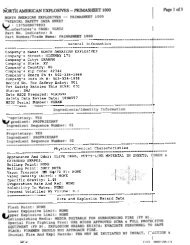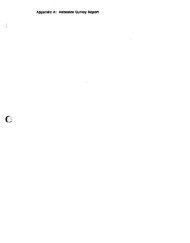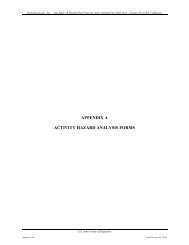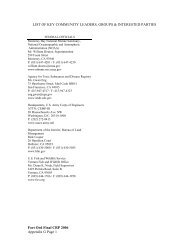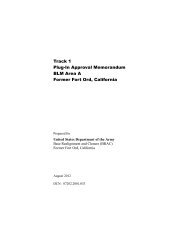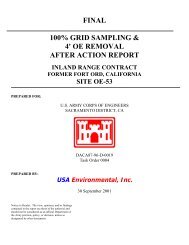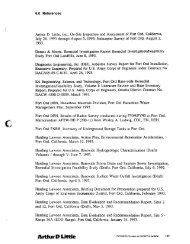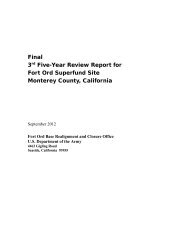Final Second Five-Year Review Report Fort Ord Superfund Site ...
Final Second Five-Year Review Report Fort Ord Superfund Site ...
Final Second Five-Year Review Report Fort Ord Superfund Site ...
You also want an ePaper? Increase the reach of your titles
YUMPU automatically turns print PDFs into web optimized ePapers that Google loves.
8.0 SITE 3 ROD<br />
This section presents background information on the <strong>Site</strong> 3 Interim ROD; a summary of remedial actions<br />
and a technical assessment of the actions taken at this site; identifies any issues related to the<br />
protectiveness of the remedy based on the review; presents recommendations and follow-up actions, if<br />
needed, to address issues identified during the review; and provides a statement regarding the<br />
protectiveness of the site remedy.<br />
8.1 Background<br />
<strong>Site</strong> 3, the Beach Trainfire Ranges, extends approximately 3.2 miles along the coastline of Monterey Bay<br />
at the western boundary of <strong>Fort</strong> <strong>Ord</strong>, and was used for small arms training since the 1940s. In general,<br />
trainees fired small arms weapons from firing lines in the eastern portion of the site toward targets spaced<br />
at varying intervals to the west. Spent ammunition accumulated on the east-facing (leeward) sides of the<br />
sand dunes that formed the "backstops" for the targets. <strong>Site</strong> 3 is proposed for reuse as a state park<br />
consisting of hiking trails, campgrounds, and ancillary facilities. The excavation of contaminated soil on<br />
this site is complete. A post remediation risk assessment for both ecological and human health was<br />
completed (HLA, 1998c, IT, 2000b). The Army has completed a proposed plan, public comment period,<br />
and ROD addressing ecological risks at this site as described in Section 8.2.5.<br />
<strong>Site</strong> 3 is also known as MRS 22 (see Section 13, which addresses MEC-related issues).<br />
8.2 Remedial Actions<br />
8.2.1 Soil Remedial Unit<br />
A human health based level of concern of 1,860 mg/kg for lead in soil was developed. Concentrations of<br />
lead above 1,860 mg/kg occur mainly in areas where greater than 10 percent of the surface is covered by<br />
spent ammunition. Although some areas with moderate bullet distribution contain lead above the human<br />
health based level of concern, the ERA recommended remediation only in areas of heavy bullet<br />
distribution to minimize impacts to the sensitive ecological habitat in other areas. Therefore, the SRU is<br />
defined by those areas of heavy bullet distribution (greater than 10 percent).<br />
8.2.2 Remedy Selection<br />
• Alternative 1: No Further Action<br />
• Alternative 2: Excavation, screening and soil treatment<br />
• Alternative 3: Excavation, screening and onsite disposal<br />
Selected Remedy<br />
Alternative 3 was the selected remedy and consists of mechanical and hand excavation of areas with<br />
greater than 10 percent coverage of spent ammunition and soil followed by mechanical separation using<br />
screens and gravity-feed separation techniques. Excavated soil would be placed in the OU 2 landfill as<br />
foundation layer, or would be disposed of at an appropriate landfill facility. This alternative provides<br />
flexibility in planning and management of the large volume of soil to be excavated from <strong>Site</strong> 3 through<br />
consideration of two options. Disposal Option 1, placement of the soil in the OU 2 landfill, would meet<br />
the intent and purpose of the CAMU regulations in that it would offer an onsite location for management<br />
of the soil in an innovative, cost-effective, and protective manner. Disposal Option 2, transportation,<br />
<strong>Final</strong><br />
8-1<br />
FORMER FT ORD 5YR REVIEW 2007_FINAL United States Department of the Army



